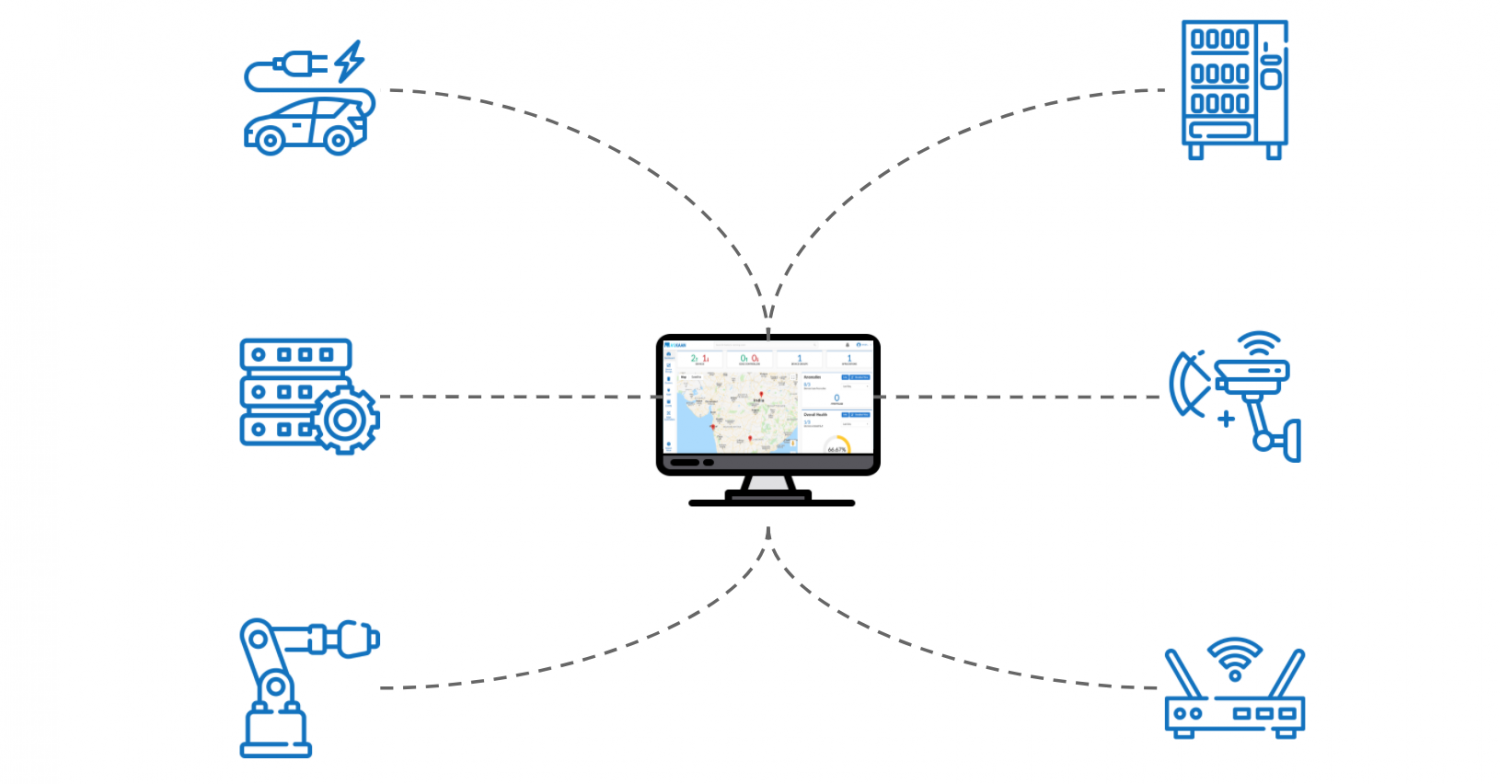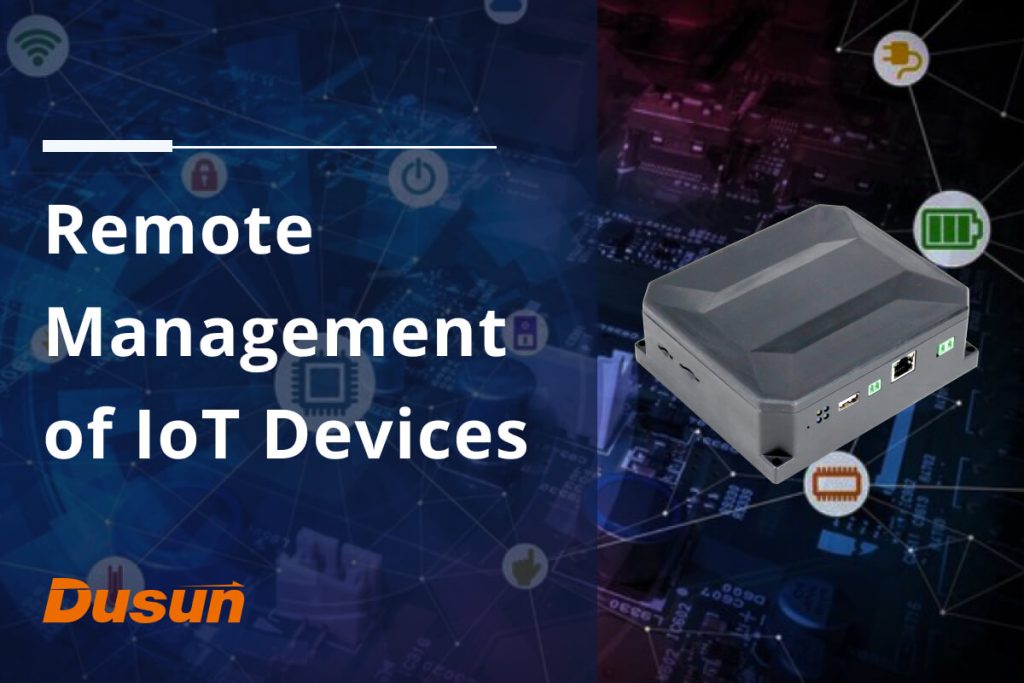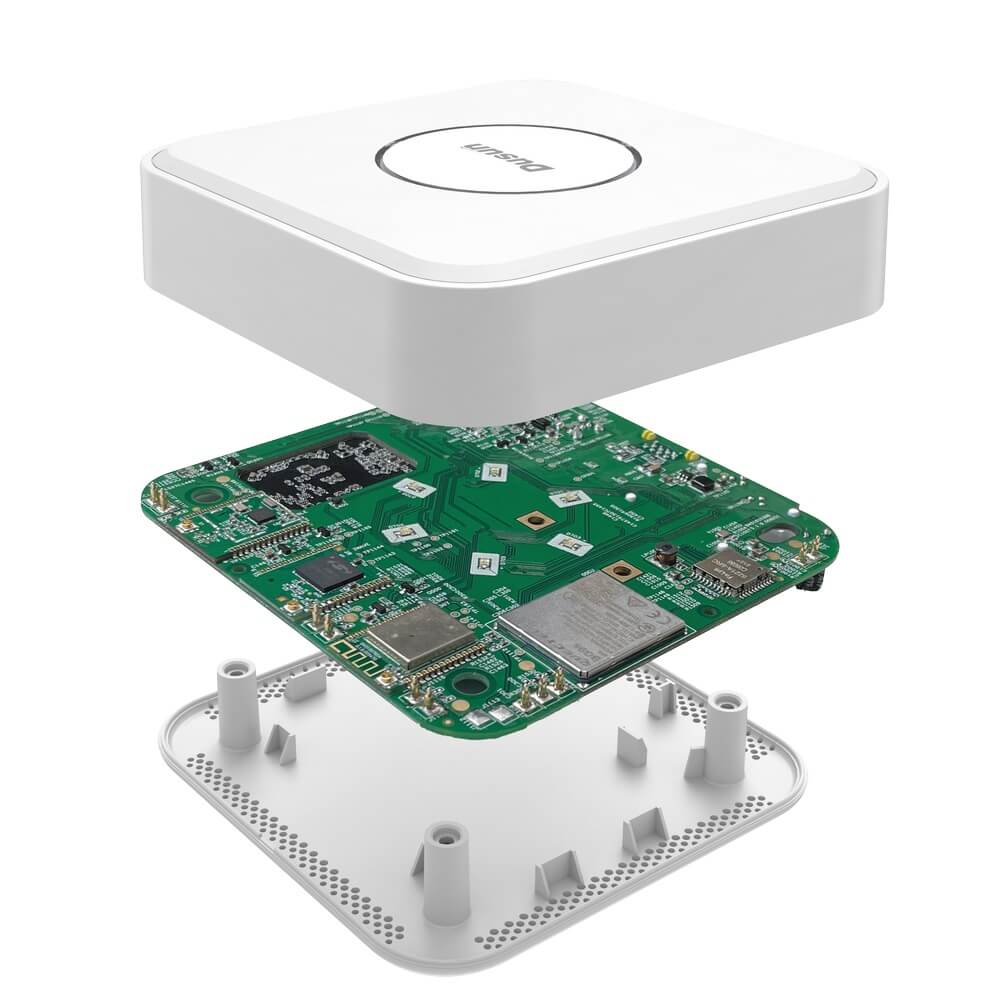Remote management of IoT devices involves monitoring and controlling IoT devices from a remote location. It plays a crucial role in the IoT ecosystem by connecting devices to network services with the help of smart IoT gateways. This capability allows equipment manufacturers to improve efficiency, reduce costs, enhance customer satisfaction, and improve security.
This article discusses how IoT gateways remotely manage IoT devices and systems, the benefits of remote management for equipment manufacturers, and the components of IoT remote management.
How Does An IoT System Work?
IoT sensors and IoT gateways are essential for achieving universal object interaction over the internet.
IoT Gateway
IoT gateways manage IoT device systems remotely by performing various functions and tasks. Here’s an overview of how an IoT gateway enables remote management of IoT devices:
- Connectivity: The IoT gateway establishes and controls the connectivity between the devices and the gateway through wired or wireless communication.
- Data Collection: The gateway collects data from connected IoT devices. This includes gathering device status, sensor readings, performance metrics, and other relevant data points.
- Data Processing: After collecting data, the gateway processes it to make it more meaningful and valuable. It involves data cleaning, filtering, aggregation, and transformation tasks.
- Analytics and Insights: The gateway may have built-in analytics capabilities or communicate with cloud-based analytics platforms. It analyses data and generates insights into device performance, trends, anomalies, and potential issues.
- Remote Control: The gateway allows administrators to control the IoT devices remotely. This includes sending commands to the machines to perform specific actions, adjusting settings, initiating firmware updates, or troubleshooting issues. Remote control capabilities enable administrators to manage and optimise device operations without physically being present at the device location.
- Security and Authentication: IoT gateways play a critical role in ensuring the security of the IoT device system. They provide secure communication channels, implement encryption protocols, authenticate devices, and enforce access control policies.
- Communication with Cloud Services: The gateway acts as a communication hub between IoT devices and cloud-based services. It transmits the collected data and relevant information to the cloud for storage, further analysis, and integration with other systems. This enables remote administrators to access and manage IoT devices from anywhere with an internet connection.
IoT Sensors
Heat, pressure, movement, humidity, and smoke are just a few of the physical phenomena that sensors (also known as end devices, physical devices, or nodes) can detect. The market continues to expand, increasing the selection of sensors as they are adopted by new industries.
Most of the time, sensors send their data over a wireless connection. Sensors must typically be as inexpensive as they can be, non-volatile, self-contained, specialized to perform a single task, and long-lasting. Due to their small size and the aforementioned requirements, it is neither practical nor cost-effective to allow sensors to connect to the internet. Because of this, sensors and IoT gateways are frequently connected.
Why Need Remote IoT Device Management?
An IoT network or system’s development and upkeep involve many different aspects of IoT device management. The following are the main justifications for why businesses need to remotely manage IoT devices.
Provisioning and Onboarding
An existing network or system must be provisioned and onboarded with any new IoT devices that are added.
A new device is connected to the system during this procedure, and the ability to communicate online is established. Verifying I/O connections, configuring network settings, and initial software and firmware setup are all tasks carried out during this stage of IoT device management.
Authentication
When introducing new devices into the system, they must first be authenticated.
In order to prevent unauthorized actors from accessing IoT equipment, authentication must also be carried out when users log into devices. Security and the capability to authenticate access to connected devices are features of a powerful IoT device management software solution.
Configuration
Simple communication between IoT devices and the system may be established with just the initial or default configuration settings.
To get the devices working properly, additional configuration is frequently needed. Device configuration can be done remotely from a single location with the help of an IoT management system.
Monitoring and Maintenance
IoT devices are frequently used in mission-critical situations that necessitate remote monitoring and maintenance.
Intelligent traffic networks and automated assembly lines need to have sensor failures quickly identified in order to maintain the safety and functionality of the systems. Monitoring can also notify a company of unauthorized attempts to access the IoT network. IoT remote management software can be used to carry out maintenance tasks like updating firmware or software to address security flaws.
Diagnostics and Generating Status Alerts
Companies can perform preventive maintenance and reduce downtime brought on by faulty system components by running diagnostics on IoT devices.
Organizations can spot devices that might be malfunctioning and replace them before they bring the system down by using an IoT remote management solution. Based on the particular requirements of an organization or IoT system, alerts can be configured and generated to indicate a variety of issues.
Control
One of the most useful capabilities of IoT device software is the capability to easily control devices remotely.
Remote control of IoT devices requires the capability to quickly take over individual devices in order to respond to emergencies or carry out urgent tasks. To enable quick changes to an IoT system, automated processes may occasionally need to be overridden. When devices need to be tested or rebooted to ensure optimal performance, remote access and control of IoT devices is also required.
Benefits of remote management for IoT devices
Remote management of IoT devices offers numerous benefits for equipment manufacturers. Let’s explore some of the critical advantages of remote control:
Improved Device Reliability and Efficiency
Through remote management, manufacturers can gather valuable insights into the performance of their IoT devices. They can analyse data collected from these devices and utilise it to make informed decisions. This data-driven approach enhances the operational efficiency of equipment manufacturers.
Cost Savings
Remote management reduces travel costs by eliminating the need for on-site maintenance. Additionally, remote management enables OTA updates and firmware management, reducing the need for physical updates and maintenance.
Improved Customer Satisfaction
Remote management of IoT devices enables equipment manufacturers to address customer issues promptly. They can provide swift support and troubleshooting assistance by remotely accessing and monitoring the instruments, leading to faster resolutions and enhanced customer satisfaction. This proactive approach to customer service helps foster loyalty and strengthens the relationship between manufacturers and their customers.
Scalability
Remote management of IoT devices allows effective control of many devices spread across multiple locations without allocating additional resources. The equipment manufacturers can centrally manage their operations and ensure consistent performance and functionality across the entire network. This scalability feature allows manufacturers to expand their IoT deployments without incurring high costs or resource constraints, thus enabling efficient growth and streamlined operations.
By using remote management solutions like Dusun’s IIoT gateway DSGW-410, manufacturers can maximise the benefits of remote management and optimise their IoT device operations.
Applications of IoT remote management
Some of the most common applications of IoT remote management are:
Smart Home Automation
The most popular application of remote IoT monitoring is smart home automation. Home appliances are remotely managed with smart home gateways, enabling homeowners to control their devices from anywhere.
Industrial Automation
IoT remote management can help optimise operations, reduce downtime, and improve safety in industrial settings. Industrial IoT gateways remotely monitor and control industrial IoT devices such as sensors, controllers, and machines, enabling real-time data analysis and predictive maintenance.
You may also want to know: what is industrial gateway?
Healthcare
Healthcare providers can proactively identify potential health issues, track patient progress, and intervene when necessary by remotely monitoring and managing IoT devices through the IoT gateways. This enables them to deliver more personalised and timely care, improving remote patient monitoring outcomes.
Retail
IoT remote management, facilitated by IoT gateways, empowers retailers to increase operational efficiency. Retailers can enhance customer experiences, reduce costs, optimise stock levels, and increase operational efficiency by remotely managing IoT devices like point-of-sale, digital signage, and inventory management systems.
Transportation
Integrating IoT remote management with IoT gateway enables transportation companies to optimise their operations, improve safety measures, and minimise costs through proactive maintenance and efficient resource allocation. It includes remotely monitoring and managing IoT devices such as vehicle telematics, traffic management systems, and cargo tracking systems,
By using remote management solutions like Dusun’s IIoT gateway DSGW-210 IoT gateway controller, businesses can maximise the benefits of remote management and optimise their IoT device operations.

Components of IoT Remote Management
Several components work together to implement the functionality of remote monitoring of IoT devices.
Communication Interfaces for IoT remote management system
IoT remote management systems may use several communication interfaces, including wired and wireless.
- Ethernet
- Wi-Fi
- Bluetooth
- Zigbee
- Z-Wave
- Cellular
- CAN bus
- Sub G
- LoRa
IoT Device Management Platforms
An IoT device management platform is a solution that enables an organization to perform the functions required to operate an IoT environment efficiently. The functions include remote provisioning, configuration, authentication, control, and monitoring of IoT devices.
AWS IoT Device Management
AWS IoT Device Management simplifies the tasks necessary to provision, organize, monitor, and manage IoT devices at scale. This product is compatible with all device types and operating systems, allowing an organization to manage a complete I oT environment with the same tool.
Azure IoT Hub
Microsoft’s IoT device management solution provides secure and reliable communication between IoT applications and devices. Features include per-device authentication, scaled provisioning, and built-in device management in a cloud-hosted solution that can connect to any kind of device .
You may be interested in How to connect to Microsoft Azure Platform with Dusun Gateways?
Google Cloud IoT Core
Google Cloud IoT Core is a fully managed service for securely connecting, managing, and ingesting data from IoT devices. It offers features like device registration, security, and device state management.
It is very important to choose an IoT gateway that can perfectly connect with IoT device management platforms, which can help you increase integration, reduce security risks, and speed up time to market. Dusun IoT provides you with a package of IoT gateways that can seamlessly connect to the remote management platform, and our professional engineer team will help you connect and maintain at any time.
How to choose a suitable communication interface for specific use cases?
Choosing the appropriate communication interface for an IoT application depends on its requirements. Wired interfaces, such as Ethernet, offer reliability and security but may not provide flexibility. Wireless interfaces offer flexibility, but they need to be more secure.
- Smart Homes: For remote management of IoT devices in smart homes or smart apartments, Wi-Fi is the ideal communication interface due to its widespread availability, high bandwidth, localised control capabilities, seamless integration with voice assistants, and robust security measures.
- Smart City: Cellular communication is ideal for smart city infrastructure monitoring and fleet management applications, where devices are spread across a large geographical area and require continuous connectivity.
- Industry 4.0: Sub-GHz technology is commonly used in applications such as industrial monitoring, automation, and smart metering, where devices must communicate reliably over extended ranges while conserving power.
Dusun’s IIoT gateway DSGW-210 supports numerous interfaces such as Ethernet, Wi-Fi, 4G LTE, CAN bus, and Sub-GHz communication interfaces, offering equipment manufacturers various options depending on their application needs.
Remote access and control mechanisms
Various mechanisms can be employed for remote access and control of IoT devices. These include web-based interfaces accessed through web browsers, mobile apps for smartphones and tablets, APIs for programmatically accessing devices, remote desktop software to control devices from a distance, and command-line interfaces for advanced configuration and management tasks. Dusun’s IoT remote management system prioritises security, preventing unauthorised access to devices while facilitating remote access securely.
Data collection and analysis for monitoring and troubleshooting
IoT remote management relies on effective data collection, processing and analysis to monitor and troubleshoot devices remotely. Analytics, visualisation tools, machine learning and AI, can provide predictive insights, enabling proactive measures to address potential problems and optimise device performance.
The Dusun DSGW-210 gateway provides robust remote data collection, advanced analytics, and machine learning capabilities enabling real-time monitoring, proactive maintenance, and optimised device performance.
Over-the-air (OTA) updates and firmware management
OTA updates are vital in remotely updating and managing the firmware of IoT devices. The process involves distributing firmware updates, verifying their authenticity, remotely installing updates, implementing rollback mechanisms, and monitoring devices for firmware-related issues.
The Dusun IoT gateway offers robust OTA update and firmware management capabilities, enabling organisations to distribute and manage firmware updates efficiently for their IoT devices, ensuring optimal performance, security, and functionality at all times.
SoC Technology in IoT remote management system
SoC (System on a Chip) technology consolidates multiple functions into a single chip, such as processing, memory, communication, and sensor interfaces. It allows the system to handle complex tasks while minimising overall system costs.
SoC technology makes IoT remote management systems more scalable and flexible. The adaptability enables the systems to respond quickly to changing requirements and environments, providing enhanced remote monitoring capabilities.
Dusun’s DSGW-410 i.MX6ULL Air Compressor IIoT Gateway is an IoT remote management system that leverages SoC technology to provide robust and cost-effective remote management capabilities.
Dusun application for IoT remote management system
The DSGW-410 IIoT gateway is a powerful device that remotely manages and controls industrial equipment. It could be a perfect choice because of the following reasons.
Powerful Performance
The gateway has an ARM Cortex-A7 CPU, which provides substantial computing power to efficiently and quickly handle complex tasks of remote data collection and analysis.

Efficient Data Handling
With 512MB of RAM and 8GB of eMMC storage, the DSGW-410 can efficiently handle and store large amounts of remote monitoring IoT device data. This capability is crucial for remote management systems that require real-time monitoring, data aggregation, and analysis of IoT device data. The gateway’s ability to handle large amounts of data enables effective decision-making and optimisation of operations.
Reliable Connectivity
The gateway supports wireless communication protocols, including Wi-Fi, 4G LTE, Bluetooth, and sub-G. These extensive connectivity options provide reliable and stable communication channels for IoT devices, even in areas with limited network coverage or interference-prone environments. Including GNSS ensures accurate positioning data, enhancing the overall remote monitoring capabilities.
Enhanced Security
With built-in encryption protocols and secure authentication mechanisms, the gateway safeguards sensitive data and prevents unauthorised access, contributing to the overall performance and integrity of the remote management system.
Remote management of IoT devices FAQs
How can remote IoT monitoring be integrated into the existing IoT ecosystem?
Integrating remote IoT monitoring into an existing IoT ecosystem involves assessing the infrastructure, selecting a remote monitoring platform, establishing communication protocols, implementing data collection and transmission, integrating and analysing the data, enabling remote control and management, testing and deploying the solution, and ensuring ongoing monitoring and maintenance. By following these steps, manufacturers can enhance equipment’s monitoring capabilities and efficiently manage IoT devices remotely, enabling real-time insights and proactive maintenance.
What challenges and risks are associated with upgrading existing equipment to remote IoT monitoring?
Upgrading existing equipment to remote IoT monitoring presents challenges such as compatibility issues, security vulnerabilities, integration complexities, data privacy concerns, regulatory compliance, and financial implications. To mitigate these challenges, thorough planning, rigorous testing, and collaboration with IoT experts are crucial for successfully upgrading remote IoT monitoring.




















